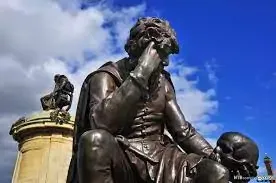Hamlet by William Shakespeare: Book Review, Summary and Analysis
Book: Hamlet Written by William Shakespeare
The Tragedy of Hamlet, Prince of Denmark, often shortened to Hamlet, is a tragedy written by William Shakespeare sometime between 1599 and 1601. It is Shakespeare's longest play, with 29,551 words. Wikipedia
- Characters: Ophelia, Claudius, Polonius, Laertes, Horatio, Gertrude, MORE
- Original language: Early Modern English
- Genre: Shakespearean tragedy, Drama
- Setting: Denmark
Who is Hamlet
Hamlet is the protagonist in Shakespeare's tragedy "Hamlet".
Hamlet, Prince of Denmark, is an idealist and perfectionist. The death of the father, the marriage of the mother to the uncle, and the ghost of the father telling Hamlet that he was killed by Claudius.
Hamlet's outlook on life has changed, and his personality has become complicated and suspicious. In the end, Hamlet dies for justice in order to avenge his father, which is regrettable and regrettable.
"Hamlet" Synopsis
"Hamlet", also known as "The Prince's Revenge", "Hamlet", "Macbeth", "King Lear" and "Othello" are called Shakespeare's "four tragedies". "Hamlet" is the longest play among Shakespeare's plays, and it is also the most prestigious play.
It has profound tragic significance and represents the highest achievement of Western Renaissance literature. The "to be or not to be" said by Hamlet in the play is even more classic among the classics.
Why Hamlet is a Masterpiece
"Hamlet" deserves to be a masterpiece, it can be a magical work, or it can be a work created by God. To put it simply, this work has been widely circulated in the world today, and it has been touched on in various fields of Western culture. If you want to learn Western culture, "Hamlet" is definitely a classic work.
Everyone in the West Thinkers should study this book in depth because, in this book, the ideas or ideas that they want to convey are not accepted by everyone.
For example, in "Hamlet" in the book, don't be attached to your mother. From the perspective of modern people, this kind of behavior may be more or less understandable, but when Shakespeare wrote this book, if he had such an idea, it was absolutely detached. of.
This does not belong to the simple love between men and women that we usually call, because "Hamlet" is too attached to his mother, which makes "Hamlet" become hesitant, hesitant, and even weak.
Even though later generations have remade the book "Hamlet" into a movie, the details described in the book have not been fully shown in the video.
Reading the original work is the greatest respect for the author. Since Shakespeare was able to create such a work, his thoughts must surpass others and be more open.
What exactly does Hamlet want to reflect?
Many people read "Hamlet" but didn't really understand it, and didn't understand what the book wanted to express. It will be easier if you look at the writing background.
When Shakespeare wrote this book, he was in the Renaissance period. What he wanted to express was the rampant bourgeoisie and the chaotic and dark age in England at that time. Relics of history.
About the Author: William Shakespeare
William Shakespeare (April 23, 1564-April 23, 1616) was a great dramatist and poet during the European Renaissance. He was born in a small merchant family in Strasford-upon-Erwen, England. In 1587, Shakespeare left his hometown and went to London.
At first, he worked as a horse guard for the theater and did chores in other houses, and later became an actor. Just play in the beginning. In 1593, Shakespeare's first long poem, Venus and Adonis, was published.
William Shakespeare is the most outstanding dramatist in the history of English literature, the most important and greatest writer of the European Renaissance, the master of humanist literature at that time, and the most outstanding literature in the world Home.
Born and raised in Stratford-upon-Avon, Shakespeare married Anne Hathaway at the age of 18, with whom they had three children: Susannah and twins Hamnet and Judith.
For more than 20 years from the end of the 16th century to the beginning of the 17th century, Shakespeare started a successful career in London.
He was not only an actor and a playwright, but also one of the partners of the Chamberlain's Theater Company, which was later renamed the King's Theater Company. Shakespeare retired to Stratford-upon-Avon around 1613, where he died three years later.
The period from 1590 to 1600 was the golden age of Shakespeare's writing. His early plays were mainly comedies and historical plays, which reached their peak of depth and artistry in the late 16th century.
From 1601 to 1608, he mainly wrote tragedies. Shakespeare advocated noble sentiments and often described sacrifice and revenge, including "Othello", "Hamlet", "King Lear" and "Macbeth", which are considered to be among the best examples in English. In the last period of his life, he began to write tragicomedies, also known as romantic dramas.
Shakespeare's handed-down works include 37 plays, 154 sonnets, and two long narrative poems. His plays have been translated into every major language and performed more often than any other playwright.
Excerpts from the original text: Hamlet
Introduction to the Story of Hamlet
"Hamlet" describes the Danish prince Hamlet's revenge for his father. When the prince was studying in Germany, his father was killed by his younger brother Claudius. The murderer covered up the truth, usurped the throne, and married the king's wife; Hamlet worked hard to understand the truth in the play.
But he fell into the metaphysical thinking of "to be or not to be", and gave up the chance of revenge. As a result, Claudius counterattacked, and he could only parry. In the sword competition, Hamlet finally awakened and bravely stabbed his enemy to death; at the same time, he was also poisoned and martyred.
"Hamlet" is a tragic work written by English playwright William Shakespeare between 1599 and 1602. The play tells that Uncle Claudius murdered Hamlet's father, usurped the throne, and married the king's widow Gertrude; Prince Hamlet avenged his uncle for his father.
"Hamlet" is the longest play among all Shakespeare's plays, and it is also Shakespeare's most famous play. It has profound tragic significance, complex characters, and rich and perfect tragic art techniques, and represents the whole of Western Renaissance literature. highest achievement. Together with "Macbeth", "King Lear" and "Othello", they form Shakespeare's "four tragedies".
"Hamlet" is Shakespeare's most famous play, and it is also the earliest, most complex, and longest of his four tragedies. In the three acts and one scene of the play, Hamlet has a monologue, which is popular both in the original text and in translation.
"Hamlet" is known as one of the four great masterpieces in Europe. Since its inception, it has been adapted many times into stage plays, operas, film and television, and other works.
William Shakespeare was an English Renaissance dramatist and poet, a master of humanist literature in the European Renaissance, and one of the founders of modern European literature. He wrote a total of 37 plays, 154 sonnets, two long poems, and other poems.
What are the main contents of Hamlet?
It mainly describes the story of Prince Hamlet of Denmark avenging his father. When the prince was studying in Germany, his father was killed by his younger brother Claudius. The murderer covered up the truth, usurped the throne, and married the king's wife; Hamlet worked hard to understand the truth in the play.
But he fell into the metaphysical thinking of "to be or not to be", and gave up the chance of revenge. As a result, Claudius counterattacked, and he could only parry. In the sword competition, Hamlet finally awakened and bravely stabbed his enemy to death; at the same time, he was also poisoned and martyred.
" Hamlet " is a tragic work written by English playwright William Shakespeare between 1599 and 1602. The play tells that Uncle Claudius murdered Hamlet's father, usurped the throne, and married the king's widow Gertrude; Prince Hamlet avenged his uncle for his father.
The story happened in Denmark, when Prince Hamlet's father was killed by his uncle, and his uncle married her mother, and he became the king of Denmark. These were a great blow to Prince Hamlet of Denmark. In the past, he lived a carefree life, went to college, practiced swordsmanship with friends, ate, drank, and had fun. But now his life has changed drastically.
The loving father was robbed of his life, and the state power was robbed by his cruel uncle, and her mother remarried. These bad things hit Hamlet all at once, causing him to completely collapse, and even have the idea of suicide. But his fortunes change when Bernardo and Francesco discover a ghost one night on the terrace in front of the castle.
That ghost was the ghost of Hamlet's father. They observed it for two consecutive nights. On the third night, they called Horatio and found the ghost. He was Hamlet's good friend, so he decided to call this ghost Tell Hamlet. On the morning of the fourth day, he told Hamlet about it, and Hamlet was so surprised that he also decided to go and have a look.
He was a little puzzled and half-believed, so that night on the castle terrace, he really saw the ghost, and the ghost waved to him. He rushed like a ghost, and the ghost took him to the corner and told him that his father had been killed by his uncle. Venom poured into his ear.
Now the ghost needs Hamlet to avenge him. After speaking, the ghost disappeared. At this time, Horatio and Bernardo appeared. They promised Hamlet not to tell others what they heard, and then Hamlet told them about the ghost. Then Hamlet begins to prepare for revenge, and his first impression plan is to pretend to be crazy.
Makes everyone look crazy when they see him, and makes others think he is really crazy. At this time, she fell in love with Ophelia, the daughter of a flattering minister Polonius. In order to please the king, Polonius is unwilling to let Hamlet and Ophelia touch each other, so Hamlet is very angry and becomes crazier.
His two very good friends, Rosencrantz and Guildenstern, spent his childhood with Hamlet when he was young, and these two friends, whom he thought were loyal, also fought for the king and money. , honor, betrayed him. Inquire about him for the king, and why he has gone mad. And his mother is constantly testing him. Everyone is against him.
His heart is also very safe and angry. And at this time a pair of theater troupes came and gave Hamlet a wonderful play. Hamlet told them to let them play another play. In it, Hamlet adds some fragments, which are similar to the content of the State Grid killing his father. When watching a play, look at the king's facial expression. If he is a little disturbed, it means he killed him.
He kept thinking about these things, concentrating on how to avenge the king and finally found out that it was he who killed him. After the play in the queen's bedroom, when he was talking with the queen, Polonius was entrusted by the king to hide behind the curtain and eavesdrop on their conversation.
As a result, Hamlet thought it was the king, so he drew his sword and stabbed into the curtain.
He stabbed Polonez to death with a sword, but after opening the reply, he found out that it was Polonez, and he was very regretful. Then he fled the palace in a hurry.
Polonez's daughter, Ophelia, went mad when she found out, sang songs without thinking at all, and finally committed suicide by jumping into the river. Her brother, Laertes, was furious when he came back from France and decided to kill Hamlet.
He is united with the king. The triple shackle trick was planned, so that Hamlet could not escape. But when the two of them implemented their plan, a tragedy happened. A poisonous sword was supposed to kill Hamlet, but it killed Hamlet and Laertes. Hamlet. When dying, a sword pierced the king's body.
The queen also drank the poisoned wine originally given to Hamlet and died. Finally, Fortinbras, who came to Danmai, saw the tragedy, took advantage of the fire, and returned Denmark to his territory.
Why is it said that "action" is the most brilliant stroke in Hamlet's life?
In fact, this scene also reflects the characteristics of Hamlet's actions. "To be or not to be" seems to have two options on the surface, but in fact Hamlet has no intention of accepting reality, giving up the mission of revenge, and living in the world.
He is just uneasy about the unknown afterlife. Then Hamlet realizes that too much "careful thinking" will prevent him from taking decisive action, and again feels uneasy about his delay. That's why he had the behavior of attacking from behind. The second scene of the fifth act concentratedly demonstrates his power of action in contradictions.
This is the climax and the last part of the whole tragedy. First, Hamlet tells his friend Horatio how he saw through Claudius' treachery and returned to Denmark. Then write about his sword match with Laertes and the arrangements for his funeral.
The biggest feature of Hamlet's character is the delay, but Hamlet is in action in the sword fight. It seems contradictory, but it is in line with the logic of Hamlet's character. Because fighting swords was not a strategy he took on his own initiative, when he accepted the challenge, he completely had the mentality of letting fate arrange it.
Shakespeare's description in this way reflects Hamlet's delayed character more vividly. But no matter how you say it, Hamlet finally dies with his opponent and finally completes his revenge.
The scene of this last scene is full of horror and tragedy: Hamlet, Claudius, the queen, and Laertes all die one by one, and Polonius, Ophelia, Rosenger, etc. Lands and Guildenstern, together with the old king, made a total of nine fatalities.
It can be said that at the end of the tragedy, Hamlet finally overcomes the fear of death and bravely sends out a final blow to evil. He is finally destroyed by evil, but he uses his actions to tell the world that the spirit of humanism The brilliant brilliance of the spirit and ideal also makes this work have a distinct critical significance.
What enlightenment significance does Hamlet's tragedy have?
The significance of the tragedy of Hamlet's image lies in From a positive perspective, his struggle reflects the historical progress of the uncompromising struggle between the humanist thinkers of the Renaissance and the declining feudal forces and is the product of the inevitable requirement of historical development.
From the perspective of summarizing experience and lessons, his tragedy stems from two aspects: First, the era he lived in was an era when feudal forces were still very strong, and the object of his struggle was the entire official court represented by Claudius.
Hamlet uses his personal strength to compete with this powerful evil force, and a tragic fate is inevitable. In addition, as a bourgeois humanist, he doesn't believe in the masses and believes that only "poor me" can "reset the world", has been fighting alone, and in the end, he can only die with hatred.
Secondly, the tragedy of Hamlet is also the result of the limitations of humanists' understanding of human beings under the new historical conditions at that time. He clings to the ideal of "human" in the early Renaissance, and cannot adapt to the reality that people have changed in the new historical environment.
He uses abstract anthropological theories to solve practical problems, and tragedy is inevitable. Therefore, the tragedy of Hamlet is the tragedy of the later humanists, and also the tragedy of the anthropological theory of a specific era in the late Renaissance
Hamlet Book Summary and Analysis
Hamlet's Book Review
Hamlet (drawing sword) what! Which rat thief is it? It must be fatal, I will kill you. (Piercing the curtain with a sword)Polonius (behind) Ah! I'm dead!Ouch, queen! What have you done?I don't know Hamlet; isn't that the king?Queen, what reckless and cruel behavior!Hamlet's cruel behavior! Good mother, it's as bad as killing a king and marrying his brother.The queen killed a king!Hamlet Well, mother, that's exactly what I said. (See Polonius on the drape) Goodbye, you unlucky, careless, nosy fool! ……—— "Hamlet" Act 3, Act 4, Act 5, Act 1
Hamlet, you prayed wrongly. Please don't pinch my head and neck; because although I am not an irritable person, it is very dangerous for my fire to break out, so don't annoy me. Let go of your hand!
Hamlet, hey, I'm willing to fight him over this subject until my eyelids stop blinking.
Hamlet, I love Ophelia; the love of forty thousand brothers, combined, is not worth my love for her. What are you willing to do for her?——In the first scene of the fifth act of "Hamlet"
Hamlet, you are a man, give me the glass! (Compete with Horasch for the glass) Let go! God, give it to me! (Overturning the wine glass in Horasch's hand) God, if no one can expose the truth of this matter, then how much my name will be harmed! If you ever loved me, Then please sacrifice the happiness of heaven for the time being, and stay in this cold world to bear the pain and tell the world my story.—— "Hamlet" Act 5, Scene 4,
Reading Notes: Hamlet by William Shakespeare
Book Recommender
LOOKING FOR MORE BOOKS TO READ?
Explore and find your next good read - Book Recommender for specific interests.
Discover ratings, reviews, summaries, and genres from Google Books.
Get Book Suggestions






